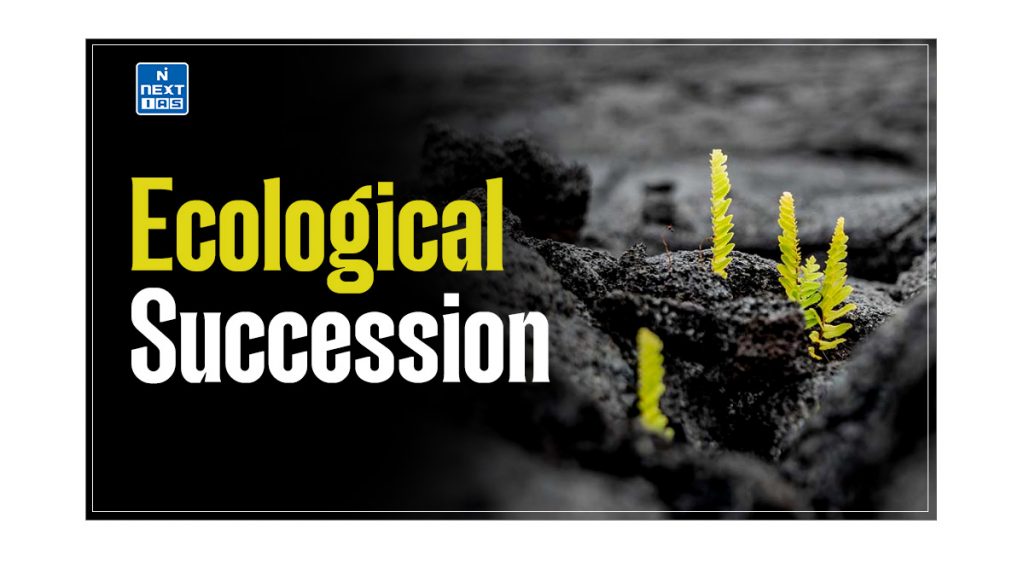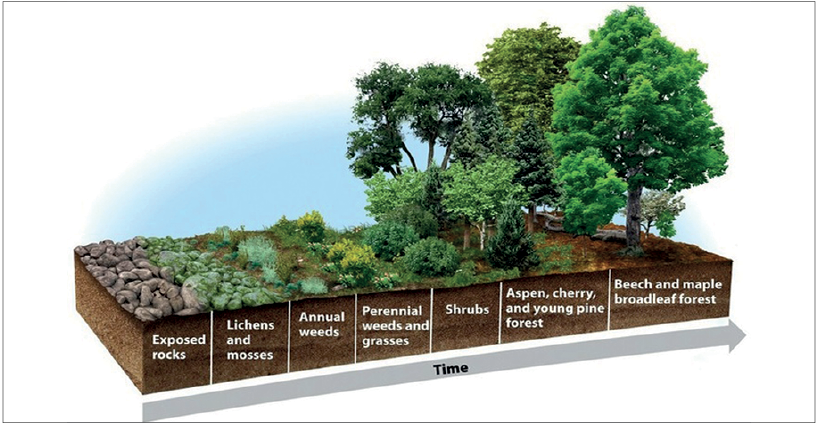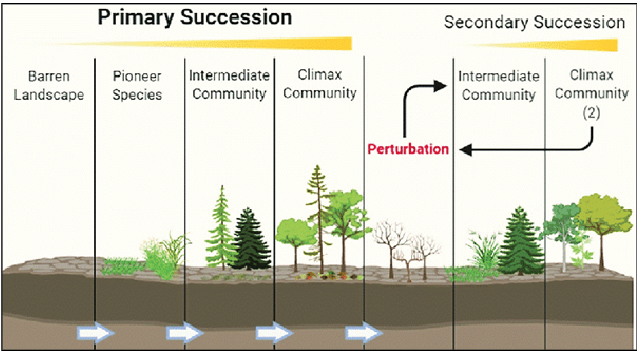
Ecological Succession is a dynamic and continuous process that shapes and determine the structure and function of ecosystems. Understanding the concept of succession is crucial to gaining insights into the ways in which ecosystems adapt to changes and disturbances. This article aims to study in detail the concept of Ecological Succession, its meaning, types, characteristics and other related concepts.
What is Ecological Succession?
- Ecological Succession is the process of gradual and predictable change in the species structure of an ecological community over a period of time.
- Succession takes place when communities replace one another due to natural or man-made destructions.
- A community starts with a relatively few pioneering animals and plants and develops through increasing complexity until it becomes stable or self-perpetuating as a climax community.

Ecological Succession: Basic Terminologies
Pioneer Species
- Pioneer Species refer to hardy species that are the first to colonise previously biodiverse steady-state ecosystems.
- For Example: in clear water – algae, mosses, freshwater eel grass, etc; in mountains, lichens are a good example of pioneer species.
- Pioneer Species show a high rate of growth but a short lifespan.
Sere
- The entire sequence of communities, succeeding one after another, is called sere.
Seral Stage
- Each transitional community that is formed and succeeded or replaced during a succession is called a seral stage or a seral community.
Climax Community
- The process of replacing one community over another is continued until a stable or self-perpetuating community develops which is in near equilibrium with its environment.
- This stable community is referred to as a Climax Community.
- Thus, the climax community can be defined as the final stage of a succession.
- Climax Communities are stable and show slow changes.
Xerosere
Succession that occurs on land where moisture content is low, such as on bare rock, is known as Xerosere.
Hydrosere
Succession that takes place in a water body, like a pond or lake, is called Hydrosere.
Categories of Ecological Succession
- Based on various parameters, there are various types of ecological succession.
- The same can be studied in the sections that follow.
Primary and Secondary Succession
Primary Succession
- Primary succession takes place over a region where no community existed previously.
- It occurs in areas that are essentially lifeless, and where soil is incapable of sustaining life as a result of factors such as newly formed sand dunes, lava flows or rocks left from a retreating glacier.
- The first species which develops on this bare land, called the pioneer community, has high growth rate but short life span.

Secondary Succession
- Secondary succession occurs in areas where a community, that existed previously, has been removed, disturbed or destroyed by reasons including natural factors like a forest fire and volcanic eruption or human interventions like tilling or harvesting lands.
- Here, the succession is much faster compared to the primary succession as the soil is already rich with required nutrients, seeds and other dormant stages of organisms.
Autogenic Succession and Allogenic Succession
Autogenic Succession
- When succession is brought about by the living organisms of that community itself, the process is called autogenic succession.
- Autogenic succession (caused by plants themselves) is succession driven by the biotic components of an ecosystem.
Allogenic Succession
- Changes brought about by outside forces are known as allogenic succession.
- In contrast to Autogenic Succession, Allogenic Succession (caused by drought, fire, flooding etc.) is driven by the abiotic components of the ecosystem.
Read our detailed article on Components of Ecosystem: Abiotic & Biotic Components
Succession in Terrestrial Community
There are many factors that decide the rate of succession and the type of climax community that would develop, including:
- The kind of substrate (rock, sand, clay) that would lead to a specific type of soil in that area.
- The climate of the area would act as the limiting factor on a species that can grow in that area.
- The climate will also determine the rate of growth of a community in that area, which would, in turn, determine the speed with which the soil is enriched with organic matter.
- All the above factors, in turn, will influence the amount of water available for plant growth.
Succession in Aquatic Habitat
- Most of the successions in an aquatic habitat is considered temporary, except in the oceans, as it is linked to the life span of the aquatic body.
- Over the period of time, the aquatic body is filled up with sediments drawn from nearby land and these ecosystem will eventually be replaced by the terrestrial ecosystem.
General Characteristics of Ecological Succession
An Ecological Succession has the following general characteristics:
- The changes in a succession are unidirectional.
- The nutrient cycle in the succession will become complex and rapid in the climax stage.
- Genetical and the species diversity of the climax community will be highly diverse.
- Over time food web become more complex.
- Over time niche differentiation and development will be very high.
- The productivity of the ecosystem in the climax stage will be high.
Disadvantages of Ecological Succession
- In the absence of competition, non-native species will eliminate the native species of the concerned ecosystem.
- For example: Water hyacinth in the lakes of Assam.
Conclusion
Ecological Succession is a dynamic process essential for ecosystem health and resilience. It highlights the interconnectedness of organisms and their environment. By understanding the intricacies of ecological succession, we can better understand the importance of conserving natural ecosystems and mitigating the impacts of human activities.
GS - 3





